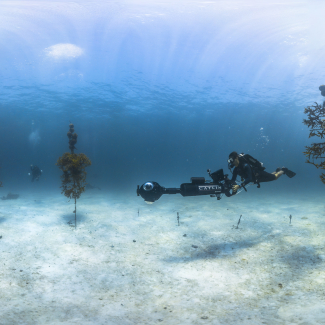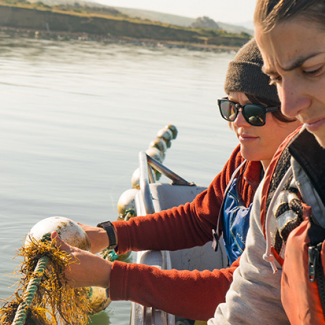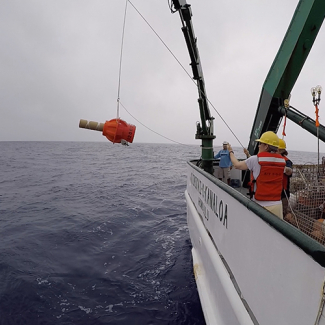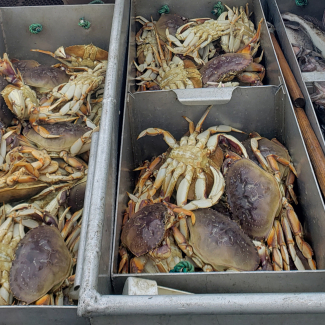According To The Animation, Where Would You Find The Lowest Ph?
In the 200-plus years since the industrial revolution began, the concentration of carbon dioxide (CO2) in the atmosphere has increased due to human deportment. During this fourth dimension, the pH of surface ocean waters has fallen past 0.1 pH units. This might not sound like much, but the pH scale is logarithmic, so this alter represents approximately a 30 percent increase in acidity.
The ocean absorbs about 30% of the carbon dioxide (COtwo) that is released in the atmosphere. As levels of atmospheric CO2 increase from human activity such every bit burning fossil fuels (e.g., car emissions) and irresolute land use (e.g., deforestation), the corporeality of carbon dioxide captivated by the ocean too increases. When CO2 is captivated by seawater, a series of chemical reactions occur resulting in the increased concentration of hydrogen ions. This process has far reaching implications for the ocean and the creatures that live there.
The pH scale
The pH calibration runs from 0 to xiv, with vii being a neutral pH. Anything college than 7 is basic (or element of group i) and anything lower than 7 is acidic. The pH scale is an inverse of hydrogen ion concentration, so more than hydrogen ions translates to higher acidity and a lower pH.
Carbon dioxide and seawater
Carbon dioxide, which is naturally in the atmosphere, dissolves into seawater. H2o and carbon dioxide combine to class carbonic acid (HtwoCOiii), a weak acid that breaks (or "dissociates") into hydrogen ions (H+) and bicarbonate ions (HCO3 -).
Considering of man-driven increased levels of carbon dioxide in the atmosphere, there is more COtwo dissolving into the ocean. The body of water's average pH is now around eight.1 offsite link, which is basic (or alkaline), simply equally the sea continues to absorb more CO2, the pH decreases and the ocean becomes more than acidic.

"Understanding how ocean acidification will touch marine life and the jobs and communities that depend on it is critical to a healthy ocean and bluish economic system," said Kenric Osgood, Ph.D., primary of the Marine Ecosystems Division, Office of Science and Technology at NOAA Fisheries Service.
Impacts of bounding main acidification on shell builders
Ocean acidification is already impacting many ocean species, especially organisms like oysters and corals that make hard shells and skeletons past combining calcium and carbonate from seawater. However, every bit sea acidification increases, bachelor carbonate ions (CO32-) bail with excess hydrogen, resulting in fewer carbonate ions available for calcifying organisms to build and maintain their shells, skeletons, and other calcium carbonate structures. If the pH gets too depression, shells and skeletons can fifty-fifty begin to dissolve.
The pteropod, or "ocean butterfly," is a tiny bounding main snail nearly the size of a small pea. Pteropods are an of import office of many food webs and eaten by organisms ranging in size from tiny krill to whales. When pteropod shells were placed in body of water water with pH and carbonate levels projected for the year 2100, the shells slowly dissolved later on 45 days. Researchers have already discovered severe levels of pteropod crush dissolution offsite link in the Southern ocean, which encircles Antarctica.

Native seaweed has the potential to be cultivated in California coastal waters and used to convalesce the effects of local ocean acidification, according to a new study funded past NOAA'south California Sea Grant.
Ocean acidification impacts on fish and seaweeds
Changes in sea chemistry can touch on the beliefs of non-calcifying organisms every bit well. The power of some fish, similar clownfish, to detect predators is decreased in more acidic waters. Studies accept shown that decreased pH levels also touch on the ability of larval clownfish offsite link to locate suitable habitat. When these organisms are at gamble, the entire food web may also exist at chance.
While some species will be harmed by bounding main acidification, algae and seagrasses may benefit from college COii weather in the ocean, every bit they require CO2 for photosynthesis but like plants on land. There are some ongoing studies examining if growing seaweed tin assist slow ocean acidification.

Four new inquiry projects are giving a boost to NOAA's ability to mensurate, track and forecast ocean acidification, warming and other of import body of water health indicators.
Our changing bounding main
Estimates of future carbon dioxide levels, based on business-as-usual emission scenarios, bespeak that past the finish of this century the surface waters of the bounding main could take a pH effectually 7.8 The last time the ocean pH was this low was during the center Miocene, 14-17 1000000 years ago. The Earth was several degrees warmer and a major extinction outcome was occurring.
Bounding main acidification is currently affecting the entire ocean, including coastal estuaries and waterways. Billions of people worldwide rely on food from the ocean equally their primary source of protein. Many jobs and economies in the U.Due south. and around the earth depend on the fish and shellfish that live in the sea.
Electric current inquiry
Sea acidification is one aspect of global climate alter. Anything we do to mitigate climatic change today will do good the futurity of the bounding main also. Over the terminal decade, there has been much focus in the ocean science community on studying the potential impacts of ocean acidification. NOAA'due south Ocean Acidification Program serves to build relationships between scientists, resources managers, policy makers, and the public in order to research and monitor the effects of changing ocean chemistry on economically and ecologically important ecosystems such as fisheries and coral reefs.
Because sustained efforts to monitor body of water acidification worldwide are merely kickoff, it is currently incommunicable to predict exactly how sea acidification impacts will pour throughout the marine food web and affect the overall structure of marine ecosystems. With the footstep of bounding main acidification accelerating, scientists, resource managers, and policymakers recognize the urgent need to strengthen the science as a footing for sound decision making and action.

A NOAA-funded study has documented that bounding main acidification along the U.S. Pacific Northwest declension is impacting the shells and sensory organs of some young Dungeness crab, a prized crustacean that supports the most valuable fishery on the Due west Coast.
Pedagogy Connexion
Ocean acidification is a problem that impacts the ocean ecosystem as well as commercial industries like oyster farms. This topic tin be taught in conjunction with lessons near food webs and ecosystems, the ecology impacts of climatic change and CO2 emissions, and chemical science lessons concerning existent-life applications. Students can explore information, including existent-fourth dimension information most carbon dioxide levels in seawater and in the atmosphere.
Source: http://www.noaa.gov/education/resource-collections/ocean-coasts/ocean-acidification
Posted by: lockefrouleem.blogspot.com

0 Response to "According To The Animation, Where Would You Find The Lowest Ph?"
Post a Comment